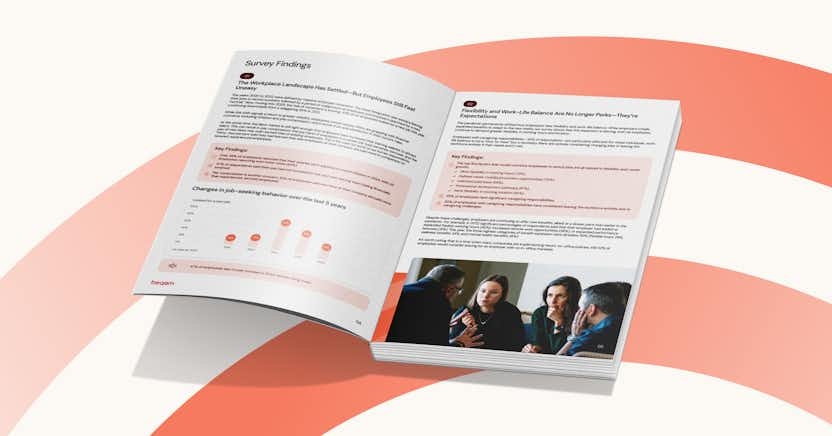
Reviewed and updated for 2025
As organizations navigate the complexities of the evolving workforce, the strategic use of technology in Human Resources (HR) has become critical. This blog explores the crucial role of HR systems to deliver on corporate objectives, automate and streamline processes, improve the employee user experience, and reduce the administrative burden on HR.
We also take a look at essential criteria for HR when evaluating technology solutions and delve into the nuanced landscape of trying to rely on HR suites versus a best-of-breed approach.
What is an HR tech stack?
The term "HR tech stack" refers to the comprehensive suite of tools and software applications that HR professionals use to manage various aspects of human resources. Just as a chef carefully selects and organizes different ingredients and methods to create a masterpiece, HR leaders curate and integrate diverse solutions to optimize HR processes, enhance employee engagement, and contribute strategically to business success.
An HR tech stack typically includes a combination of software for recruitment, onboarding, performance management, learning and development, employee engagement, compensation management, and more. These tools work synergistically to streamline HR workflows, drive efficiency, and enable data-driven decision-making. The selection of tools depends on the unique needs and objectives of the organization, reflecting its high-level philosophy for HR technology adoption.
The evolution of HR tech stack in modern businesses
The journey of HR tech stacks has undergone a significant evolution in tandem with the changing of the modern workplace. In the early stages, HR systems primarily focused on automating administrative tasks and maintaining employee records. However, as organizations recognized the strategic importance of HR in achieving business objectives, the HR tech stack evolved into a dynamic ecosystem designed to address complex challenges and leverage opportunities.
Key phases in the evolution have included:
Automation of administrative tasks
Early 2000s: The initial phase saw the adoption of HR information systems (HRIS) to automate routine administrative tasks, such as payroll processing and time tracking. Basic Applicant Tracking Systems (ATS) emerged to simplify recruitment processes.
Introduction of integrated suites
Mid-2000s to early 2010s: Integrated HR suites gained prominence, offering a unified platform for various HR functions. These suites aimed to streamline processes and enhance data consistency by providing a centralized platform for HR activities.
Focus on employee experience and engagement
Late 2010s: With the increasing emphasis on the employee experience, HR tech stacks expanded to include tools for talent management (recruiting, onboarding, learning, etc.), compensation and benefits, performance management, and employee engagement. Mobile applications and self-service portals became integral to fostering a positive workplace culture.
Rise of specialized best-of-breed solutions
Present day: The current phase witnesses a shift towards specialized best-of-breed software. Businesses are recognizing the value of choosing tools that excel in specific HR functions, providing depth and flexibility in their HR tech stacks, while delivering an improved employee experience.
Significance of the evolution
The evolution of HR tech stacks mirrors the broader transformation in HR's role—from a predominantly administrative function to a strategic partner driving company success. Modern HR tech stacks are not just about automation; they represent a strategic investment in technologies that empower HR professionals to make informed decisions, enhance employee engagement, and contribute meaningfully to achieving business objectives.
Crafting a high-level philosophy for HR technology
As organizations embark on the journey of leveraging technology in their Human Resources (HR) functions, it's helpful first to establish a high-level philosophy to guide your choices. As with most business decisions, it’s best to start with the "why" and articulate the overarching goals HR seeks to achieve for the company.
Aim for strategic alignment
Why do it? Your high-level systems philosophy must align seamlessly with the organization's overall strategic objectives. HR digital solutions should not be implemented in isolation but as a strategic enabler, contributing to the achievement of broader business goals like diversity, profit margin, market share, and so on.
How to do it. HR leaders should collaboratively engage with organizational leadership to understand key business objectives and challenges. The technology philosophy should then be crafted to align with and support these goals.
Enhance the employee experience
Why do it? A key focus of HR technology should be on enhancing the overall employee experience. By delivering value to employees, providing user-friendly interfaces, fostering collaboration, and enabling self-service capabilities, HR can create an environment where employees thrive.
How to do it. Conducting regular employee feedback surveys, analyzing pain points in HR processes, and understanding employee needs will inform the technology approach. The goal is to implement solutions that make work more meaningful and enjoyable for employees.
Drive efficiency and agility
Why do it? HR technology should be a catalyst for operational efficiency and agility. By automating repetitive tasks, streamlining workflows, and providing real-time insights, HR contributes to the organization's ability to adapt swiftly to changing market dynamics.
How to do it. Assessing current HR processes, identifying bottlenecks, and evaluating the capability and adaptability of existing systems will guide the decision-making process. The aim is to implement an HR platform that not only addresses current needs but also scales as the organization evolves.
Enable data-driven decision-making
Why do it? A high-level philosophy should emphasize the importance of leveraging data for informed decision-making. HR technology should provide the tools and analytics necessary to transform raw data into actionable insights, empowering HR professionals to make strategic decisions.
How to do it. Assessing the company's data maturity, identifying critical HR metrics, and understanding the capabilities of offerings in the market to support strategic decision-making at all levels will guide the choice of technology that aligns with this philosophy.
Cultivate a culture of continuous improvement
Why do it? The philosophy behind HR technology should embrace a culture of continuous improvement. Solutions should not be static but evolve to meet changing organizational needs, staying abreast of industry trends and workplace regulations, and driving innovation.
How to do it. Regularly evaluating the effectiveness of existing technology, staying informed about emerging HR tech trends, and fostering a culture of innovation within the HR team contribute to a philosophy that embraces ongoing improvement.
In essence, the high-level philosophy behind the HR tech stack should be a strategic roadmap, guiding the business towards success. It is the articulation of what HR aims to achieve and why technology is a critical enabler in achieving those objectives. Crafting this philosophy involves aligning with corporate goals, prioritizing employees, driving efficiency and agility, leveraging data, and fostering a culture of continuous improvement. As companies embark on the transformative journey of HR technology adoption, a well-defined and thoughtfully considered high-level philosophy will serve as the North Star, ensuring that technology becomes a powerful ally in achieving organizational excellence.
The growing importance of technology in HR
As Josh Bersin has framed it, we are now entering a post industrial economy. The industrial revolution over the last 150 years has created massive amounts of automation and productivity-enhancing advancements. The result is that employees no longer are just replaceable commodities, needed for menial tasks. They are more skilled and specialized than ever before, and that trend is only going to continue with the blossoming of artificial intelligence. Now, says Bersin, “every company is in the people business.” HR is more important than ever, and the HR tech stack plays a key role in shaping today’s high performing organization in many ways, including:
Efficiency and productivity
In a fast-paced business environment, efficiency is key. Technology enables HR professionals to automate repetitive tasks and streamline complex processes. Whether in recruiting (resume screening, scheduling interviews, managing employee records), compensation (salary planning, merit increases, pay equity) or performance management (goal-setting, collecting feedback, performance reviews)—to name a few examples—the use of technology not only saves time but also allows HR teams to focus on strategic initiatives that contribute to the overall productivity of the organization.
Data-driven decision-making
Technology provides HR with tools to collect, analyze, and interpret data, and to make predictions. This data-driven approach enables HR professionals to make informed decisions regarding talent acquisition, employee engagement, compensation strategy, and workforce planning. Harnessing the power of workforce analytics can lead to more effective strategies and better outcomes for the business.
Remote work and collaboration
With the rise of remote work, HR technology facilitates seamless collaboration between dispersed teams. Virtual onboarding processes, digital communication tools, feedback platforms, self-service tools, and remotely administered systems are among the essential components that enable HR to adapt to the changing dynamics of the modern workplace.
Impact of technology on different areas of HR
Virtually every aspect of HR can be improved and accelerated through the use of digital solutions. It is up to HR leaders to determine what areas can have the most impact on the organization’s success and prioritize accordingly.
Recruitment and talent acquisition
Technology streamlines the recruitment process by leveraging artificial intelligence (AI) for resume screening and predictive analytics for identifying top talent. Applicant Tracking Systems (ATS) automate the hiring pipeline, reducing time-to-fill and ensuring a more efficient recruitment process.
Learning and development
HR software facilitates personalized learning experiences through e-learning platforms and Learning Management Systems (LMS). This not only enhances employee skills but also ensures that training programs align with organizational goals and industry trends.
Compensation management and pay equity
Technology can play a pivotal role in transforming compensation management, which is a critical core function. These solutions empower HR professionals to create transparent pay structures, conduct market analysis, design flexible compensation strategies, support data-driven pay decisions at all levels, and administer rewards efficiently. Advanced pay equity tools can ensure ongoing fair pay and legal compliance.
Collaboration and coaching
Integrated collaboration platforms facilitate seamless communication among dispersed teams, enhancing the employee experience and contributing to increased productivity. Support for manager coaching takes collaboration one step further and aids in employee-manager alignment.
Goal-setting and tracking
Software provides automation for setting and tracking individual and team goals, speeding up the cascading of high level goals throughout the organization, fostering real-time evaluation and progress tracking, and promoting a more dynamic performance management process.
Continuous feedback and recognition
Automated feedback and recognition tools contribute to a positive workplace culture by ensuring timely acknowledgment of employee achievements, fostering a sense of appreciation and motivation, as well as supporting continuous improvement.
360-degree feedback
Performance management tools enable the automation of 360-degree feedback processes, providing a holistic view of employee performance from various perspectives within the enterprise.
Performance appraisal and calibration
Automation in performance appraisal processes, including calibration features, ensures consistency and fairness in evaluating employee performance across the organization, and saves enormous amounts of time.
Impact on the business, employees, and HR staff
HR technology has something to benefit everyone in the organization.
Business impact
Implementing HR technology positively affects the bottom line. Improved efficiency, better talent management, and data-driven decision-making contribute to overall business success. The adaptability of HR tech to changing market demands ensures that businesses stay competitive and agile, and attract and retain needed talent.
Employee experience
From recruitment to retirement, HR technology enhances the employee experience. Self-service portals, mobile applications, and digital communication tools empower employees, providing them with the tools they need to thrive in the workplace. This, in turn, contributes to a positive workplace culture, motivation, productivity, and loyalty.
HR department and staff
HR professionals benefit from technology by automating administrative tasks, allowing them to focus on strategic HR functions. Access to real-time data also equips HR staff with the insights needed to make informed decisions. This shift from transactional to strategic roles enhances the value HR brings to the organization.
Risks of not embracing technology in HR
Conversely, failure to keep up with the advances in HR technology can put your company at a competitive disadvantage. Organizations that fail to embrace HR digital solutions risk falling behind competitors who leverage these tools for strategic advantage. The ability to attract and retain top talent often hinges on the adoption of modern HR practices and technology. Employees want to work for a company with efficient processes, and increasingly, for companies that practice transparency and workplace equity.
Manual processes are prone to errors and inefficiencies, both of which are costly. Without the aid of technology, HR departments may struggle with accuracy in record-keeping, compliance issues, and inefficient workflows, hindering the overall effectiveness of HR operations.
Building a tech stack for HR
So how to best approach technology adoption for HR?
Assess organizational needs. Before implementing an HR solution, HR executives should conduct a thorough assessment of the organization's needs. Understanding specific pain points, goals, and desired outcomes is essential for choosing the right solutions. What are the company’s objectives and what would be needed to accomplish them?
Identify critical areas. These are areas where you can gain the most strategic benefit, and where you therefore do not want to compromise on functionality. What is mission critical, what is core to realizing your strategy and achieving your goals? In other words, what is most worthy of investment?
Consider integration and scalability. A well-rounded tech stack should be easily integrable with existing systems and scalable to accommodate future growth. Seamless integration ensures data consistency and avoids silos, while scalability future-proofs the technology against evolving organizational needs.
Criteria for evaluating HR technology solutions
Here are some key areas to consider when evaluating technology solutions.
Functional coverage
First and foremost, technology solutions should be able to do what you need done. You should not have to compromise on your strategy to conform to system limitations. If a solution cannot really handle your needs, scan the market to see if there is an alternative that is a better fit for your needs.
Integration capabilities
Seamless integration with existing systems is crucial for data consistency and efficient workflows. HR professionals should prioritize technology solutions that support interoperability.
Scalability and global compatibility
Large organizations must choose solutions that are scalable to accommodate their size and adaptable to meet global complexities and diverse compliance requirements. Global compatibility supports consistency in HR practices across different regions.
User experience and accessibility
A user-friendly interface and accessibility across devices are critical considerations. HR technology should be intuitive for users globally, promoting widespread adoption and engagement. And remember that part of the user experience is delivering real value to the end users.
Data security and compliance
Given the sensitivity of HR data, security features and compliance with data protection regulations should be paramount. Robust security measures safeguard against data breaches and ensure confidentiality.
Vendor expertise and support
Every solution has people behind it who create, implement, update, and support it. Even the most intuitive systems need support to keep the technology improving and advancing, look for expertise and a commitment to innovation.
Comparing HR suites and best-of-breed solutions
It is often tempting to try to rely on your core HR suite to handle most or all of your HR software needs. However, the benefit of a single source supplier is limited compared to the possible benefits of a best-of-breed approach.
Limitations of HR suites
Some of the common problems encountered when trying to stretch an HR suite to cover every need include:
Lack of specialization. Comprehensive HR suites often provide a generalist approach, attempting to cover a broad spectrum of HR functions. While this may be suitable for some organizations, it can result in a lack of depth for specialized functions like compensation management and performance management.
Slower innovation. The sheer size and complexity of comprehensive suites can sometimes lead to slower adaptation to emerging technologies and industry trends. The bureaucratic processes involved may hinder the swift integration of innovative solutions that could benefit the organization.
Complex implementation. Implementing extensive HR suites can be intricate and resource-intensive, requiring substantial time and effort. The complexity of these systems may lead to challenges in user adoption and ongoing maintenance.
Advantages of a best-of-breed HR tech approach
What is driving companies to seek best-of-breed solutions within their HR tech stack? Some reasons include:
Specialization. Best-of-breed solutions excel in specific HR functions, providing advanced features and customization options tailored to the organization's unique needs. This specialization ensures that each component of the HR tech stack is functionally rich and optimized for maximum efficiency.
Faster innovation. Specialized providers often innovate more rapidly, adapting to industry trends and technological advancements with agility. This proactive approach allows organizations to stay at the forefront of HR technology, driving continuous improvement.
Flexibility and integration. Best-of-breed solutions offer flexibility and can be seamlessly integrated with other systems. This allows organizations to build a tailored tech stack that aligns precisely with their requirements, avoiding the constraints of a one-size-fits-all solution.
A best-of-breed HR technology success story
One large multinational bank was facing an increasingly complex and competitive landscape including new non-traditional players, increasing regulation, artificial intelligence, and automation. These challenges made it crucial for them to attract, retain, and leverage their human capital to its fullest potential.
They wanted to give employees and line managers a uniform and engaging experience, and establish a culture of continuous improvement, and so were seeking best of breed solutions for key HR processes to complement their core SAP HCM solution.
beqom enabled crowdsourced real-time continuous feedback, regular check-ins, and agile goal setting, supporting managers in providing timely and helpful coaching. With pulse surveys, structured 360 feedback and insightful analytics, the solution measures the entire employee experience at every touchpoint.
With beqom they can align personalized rewards with real-time performance data, as well as with feedback, skills, behavior, and goals, to provide meaningful and effective rewards. The bank was able to consolidate all compensation processes, including salary and promotion increases, short and long-term incentives, and cash awards, across more than 30 countries.
And, their compensation budget can be continuously monitored as performance ratings are submitted and their cost impact calculated. All in all, it’s a real success story that shows the power of HR technology to transform an organization.
Moving forward with your HR technology stack
In today’s dynamic workplace, technology solutions will play a pivotal role in empowering HR professionals to deliver value for the organization. To find out how best-of-breed solutions can transform your HR processes and help you build a high-performing organization, take a positive first step and contact us at beqom.
















